TAEASS401 Plan Assessment Activities & Processes: Detailed Solution
VerifiedAdded on 2023/06/10
|7
|1617
|194
Homework Assignment
AI Summary
This document provides a comprehensive solution for TAEASS401, focusing on planning assessment activities and processes within the context of Registered Training Organisations (RTOs). It covers key aspects such as RTO standards, the importance of skilled trainers and assessors, and the principles and rules of evidence in assessment. The solution also details various assessment methods, including diagnostic, formative, interim, and summative assessments, and highlights the essential components of an assessment, such as context, conditions, tasks, and evidence guidelines. Furthermore, it discusses the relevance of oral and written questions, observation checklists, projects, scenarios, and case studies in enhancing student knowledge and ensuring the integrity and validity of the assessment process. This resource is useful for students seeking a detailed understanding of assessment planning and implementation in vocational education and training.
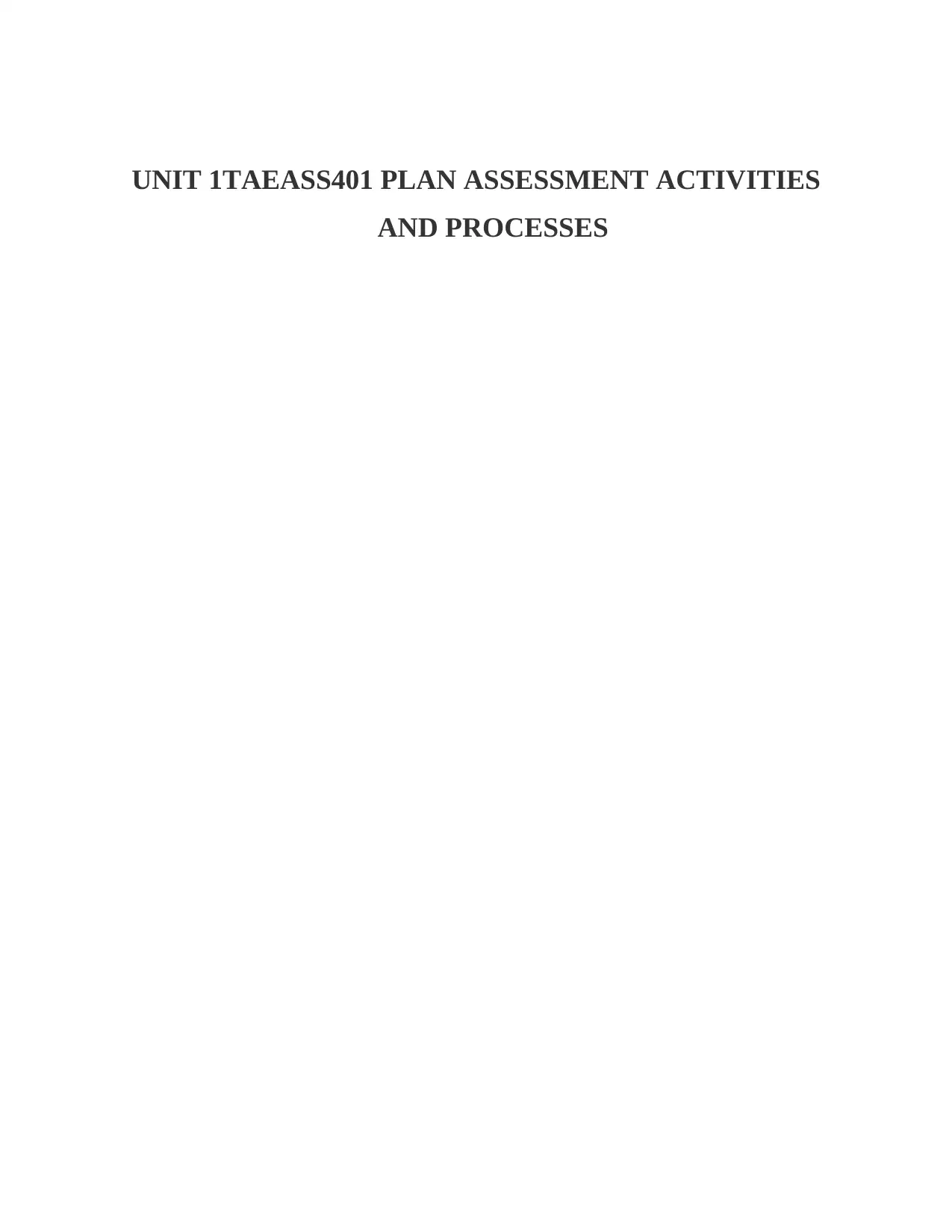
UNIT 1TAEASS401 PLAN ASSESSMENT ACTIVITIES
AND PROCESSES
AND PROCESSES
Paraphrase This Document
Need a fresh take? Get an instant paraphrase of this document with our AI Paraphraser
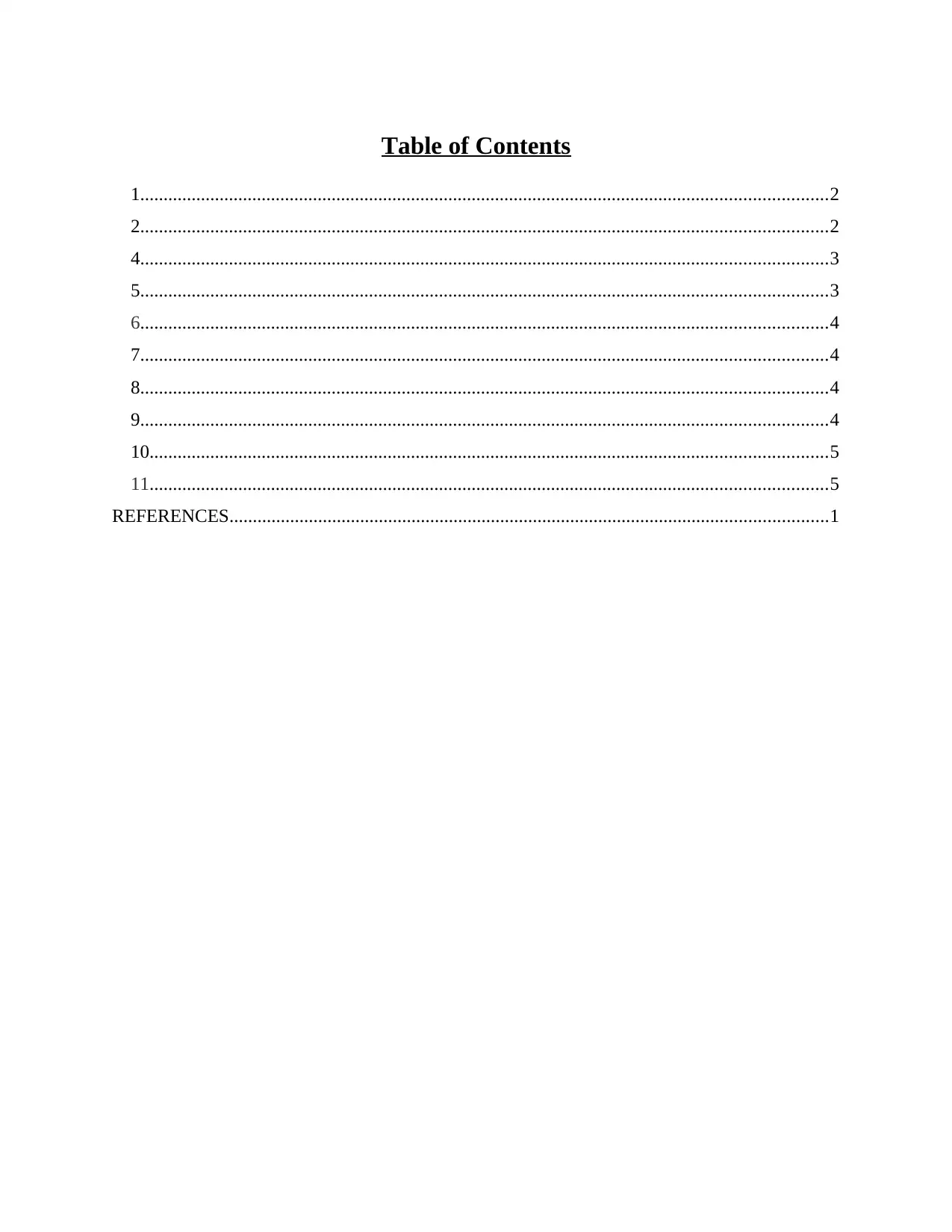
Table of Contents
1...................................................................................................................................................2
2...................................................................................................................................................2
4...................................................................................................................................................3
5...................................................................................................................................................3
6...................................................................................................................................................4
7...................................................................................................................................................4
8...................................................................................................................................................4
9...................................................................................................................................................4
10.................................................................................................................................................5
11.................................................................................................................................................5
REFERENCES................................................................................................................................1
1...................................................................................................................................................2
2...................................................................................................................................................2
4...................................................................................................................................................3
5...................................................................................................................................................3
6...................................................................................................................................................4
7...................................................................................................................................................4
8...................................................................................................................................................4
9...................................................................................................................................................4
10.................................................................................................................................................5
11.................................................................................................................................................5
REFERENCES................................................................................................................................1
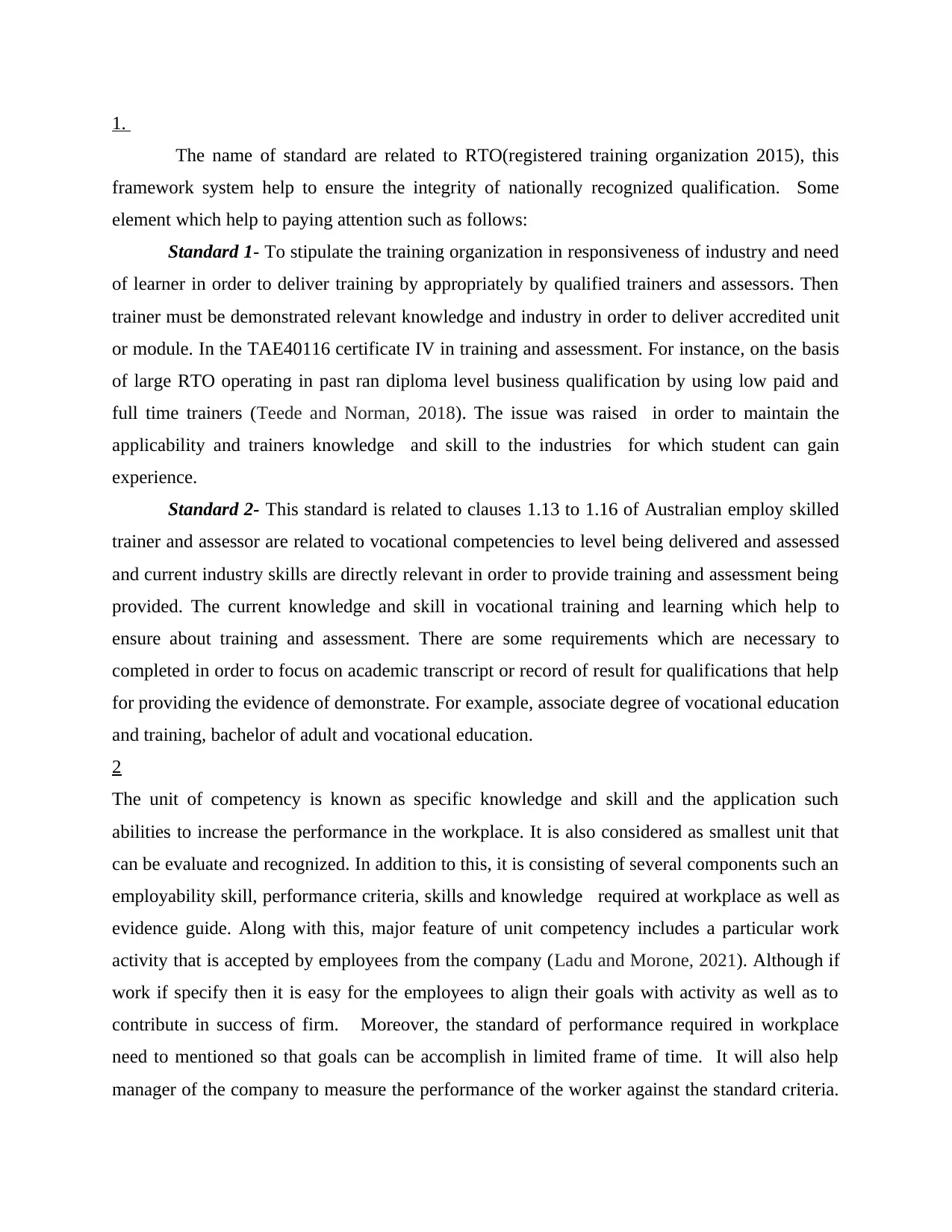
1.
The name of standard are related to RTO(registered training organization 2015), this
framework system help to ensure the integrity of nationally recognized qualification. Some
element which help to paying attention such as follows:
Standard 1- To stipulate the training organization in responsiveness of industry and need
of learner in order to deliver training by appropriately by qualified trainers and assessors. Then
trainer must be demonstrated relevant knowledge and industry in order to deliver accredited unit
or module. In the TAE40116 certificate IV in training and assessment. For instance, on the basis
of large RTO operating in past ran diploma level business qualification by using low paid and
full time trainers (Teede and Norman, 2018). The issue was raised in order to maintain the
applicability and trainers knowledge and skill to the industries for which student can gain
experience.
Standard 2- This standard is related to clauses 1.13 to 1.16 of Australian employ skilled
trainer and assessor are related to vocational competencies to level being delivered and assessed
and current industry skills are directly relevant in order to provide training and assessment being
provided. The current knowledge and skill in vocational training and learning which help to
ensure about training and assessment. There are some requirements which are necessary to
completed in order to focus on academic transcript or record of result for qualifications that help
for providing the evidence of demonstrate. For example, associate degree of vocational education
and training, bachelor of adult and vocational education.
2
The unit of competency is known as specific knowledge and skill and the application such
abilities to increase the performance in the workplace. It is also considered as smallest unit that
can be evaluate and recognized. In addition to this, it is consisting of several components such an
employability skill, performance criteria, skills and knowledge required at workplace as well as
evidence guide. Along with this, major feature of unit competency includes a particular work
activity that is accepted by employees from the company (Ladu and Morone, 2021). Although if
work if specify then it is easy for the employees to align their goals with activity as well as to
contribute in success of firm. Moreover, the standard of performance required in workplace
need to mentioned so that goals can be accomplish in limited frame of time. It will also help
manager of the company to measure the performance of the worker against the standard criteria.
The name of standard are related to RTO(registered training organization 2015), this
framework system help to ensure the integrity of nationally recognized qualification. Some
element which help to paying attention such as follows:
Standard 1- To stipulate the training organization in responsiveness of industry and need
of learner in order to deliver training by appropriately by qualified trainers and assessors. Then
trainer must be demonstrated relevant knowledge and industry in order to deliver accredited unit
or module. In the TAE40116 certificate IV in training and assessment. For instance, on the basis
of large RTO operating in past ran diploma level business qualification by using low paid and
full time trainers (Teede and Norman, 2018). The issue was raised in order to maintain the
applicability and trainers knowledge and skill to the industries for which student can gain
experience.
Standard 2- This standard is related to clauses 1.13 to 1.16 of Australian employ skilled
trainer and assessor are related to vocational competencies to level being delivered and assessed
and current industry skills are directly relevant in order to provide training and assessment being
provided. The current knowledge and skill in vocational training and learning which help to
ensure about training and assessment. There are some requirements which are necessary to
completed in order to focus on academic transcript or record of result for qualifications that help
for providing the evidence of demonstrate. For example, associate degree of vocational education
and training, bachelor of adult and vocational education.
2
The unit of competency is known as specific knowledge and skill and the application such
abilities to increase the performance in the workplace. It is also considered as smallest unit that
can be evaluate and recognized. In addition to this, it is consisting of several components such an
employability skill, performance criteria, skills and knowledge required at workplace as well as
evidence guide. Along with this, major feature of unit competency includes a particular work
activity that is accepted by employees from the company (Ladu and Morone, 2021). Although if
work if specify then it is easy for the employees to align their goals with activity as well as to
contribute in success of firm. Moreover, the standard of performance required in workplace
need to mentioned so that goals can be accomplish in limited frame of time. It will also help
manager of the company to measure the performance of the worker against the standard criteria.
⊘ This is a preview!⊘
Do you want full access?
Subscribe today to unlock all pages.

Trusted by 1+ million students worldwide
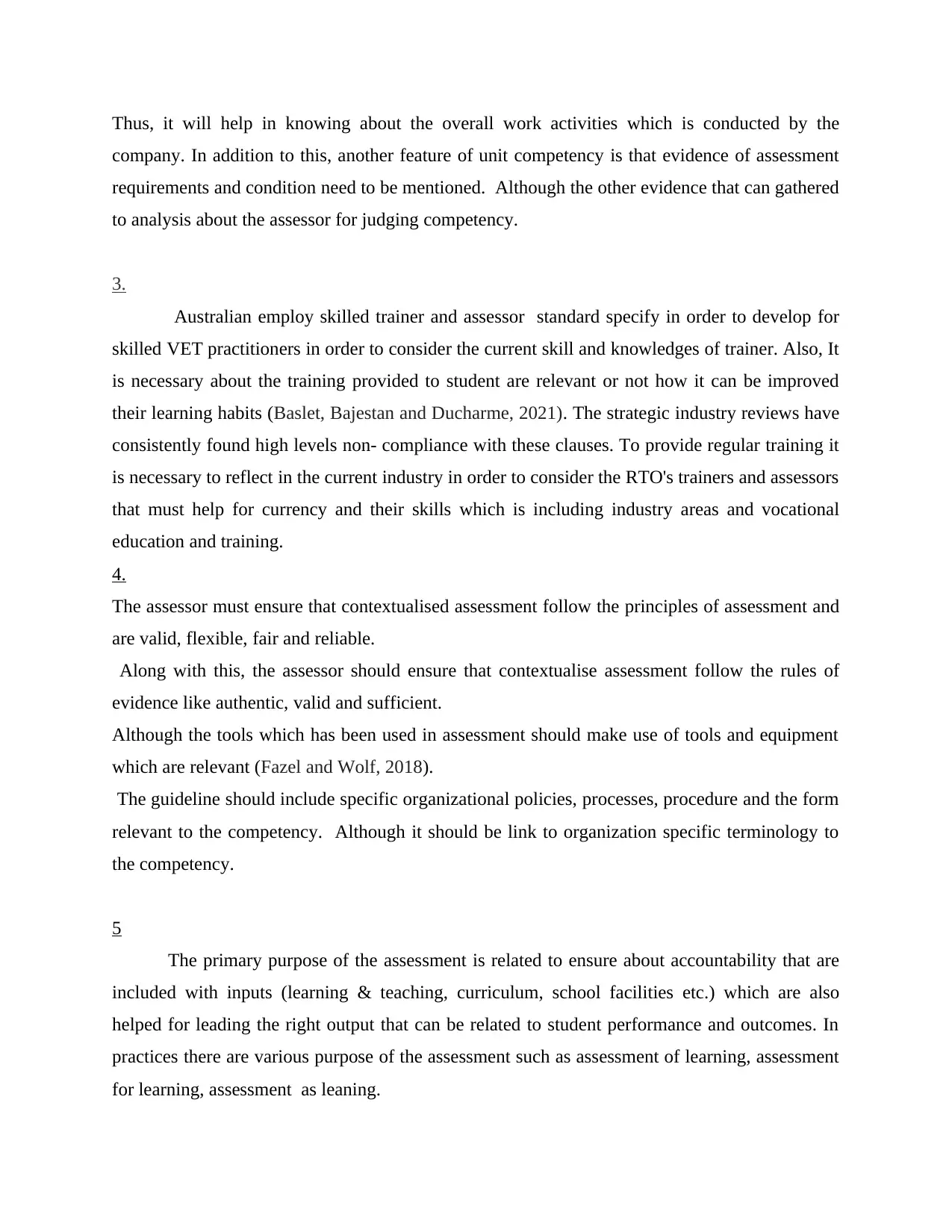
Thus, it will help in knowing about the overall work activities which is conducted by the
company. In addition to this, another feature of unit competency is that evidence of assessment
requirements and condition need to be mentioned. Although the other evidence that can gathered
to analysis about the assessor for judging competency.
3.
Australian employ skilled trainer and assessor standard specify in order to develop for
skilled VET practitioners in order to consider the current skill and knowledges of trainer. Also, It
is necessary about the training provided to student are relevant or not how it can be improved
their learning habits (Baslet, Bajestan and Ducharme, 2021). The strategic industry reviews have
consistently found high levels non- compliance with these clauses. To provide regular training it
is necessary to reflect in the current industry in order to consider the RTO's trainers and assessors
that must help for currency and their skills which is including industry areas and vocational
education and training.
4.
The assessor must ensure that contextualised assessment follow the principles of assessment and
are valid, flexible, fair and reliable.
Along with this, the assessor should ensure that contextualise assessment follow the rules of
evidence like authentic, valid and sufficient.
Although the tools which has been used in assessment should make use of tools and equipment
which are relevant (Fazel and Wolf, 2018).
The guideline should include specific organizational policies, processes, procedure and the form
relevant to the competency. Although it should be link to organization specific terminology to
the competency.
5
The primary purpose of the assessment is related to ensure about accountability that are
included with inputs (learning & teaching, curriculum, school facilities etc.) which are also
helped for leading the right output that can be related to student performance and outcomes. In
practices there are various purpose of the assessment such as assessment of learning, assessment
for learning, assessment as leaning.
company. In addition to this, another feature of unit competency is that evidence of assessment
requirements and condition need to be mentioned. Although the other evidence that can gathered
to analysis about the assessor for judging competency.
3.
Australian employ skilled trainer and assessor standard specify in order to develop for
skilled VET practitioners in order to consider the current skill and knowledges of trainer. Also, It
is necessary about the training provided to student are relevant or not how it can be improved
their learning habits (Baslet, Bajestan and Ducharme, 2021). The strategic industry reviews have
consistently found high levels non- compliance with these clauses. To provide regular training it
is necessary to reflect in the current industry in order to consider the RTO's trainers and assessors
that must help for currency and their skills which is including industry areas and vocational
education and training.
4.
The assessor must ensure that contextualised assessment follow the principles of assessment and
are valid, flexible, fair and reliable.
Along with this, the assessor should ensure that contextualise assessment follow the rules of
evidence like authentic, valid and sufficient.
Although the tools which has been used in assessment should make use of tools and equipment
which are relevant (Fazel and Wolf, 2018).
The guideline should include specific organizational policies, processes, procedure and the form
relevant to the competency. Although it should be link to organization specific terminology to
the competency.
5
The primary purpose of the assessment is related to ensure about accountability that are
included with inputs (learning & teaching, curriculum, school facilities etc.) which are also
helped for leading the right output that can be related to student performance and outcomes. In
practices there are various purpose of the assessment such as assessment of learning, assessment
for learning, assessment as leaning.
Paraphrase This Document
Need a fresh take? Get an instant paraphrase of this document with our AI Paraphraser
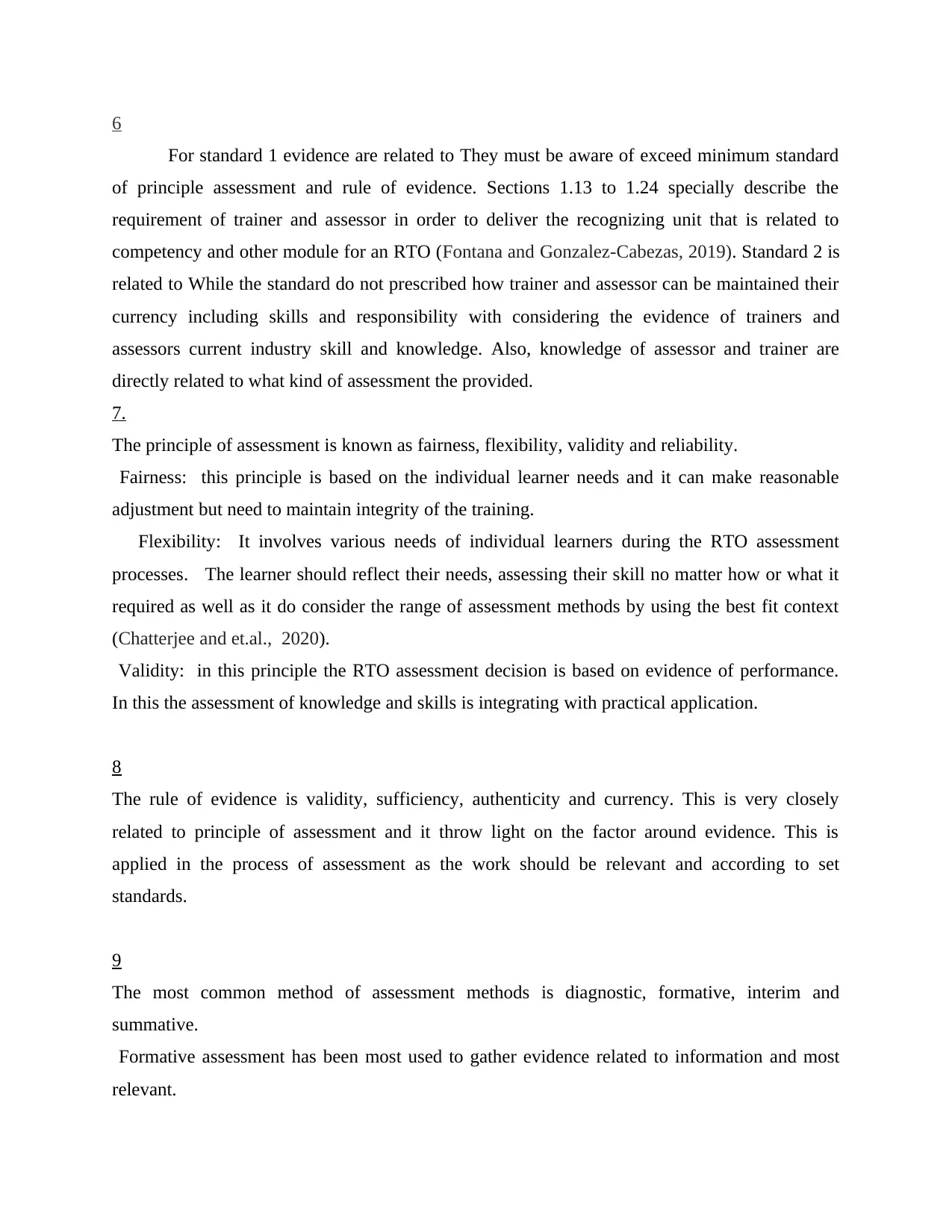
6
For standard 1 evidence are related to They must be aware of exceed minimum standard
of principle assessment and rule of evidence. Sections 1.13 to 1.24 specially describe the
requirement of trainer and assessor in order to deliver the recognizing unit that is related to
competency and other module for an RTO (Fontana and Gonzalez-Cabezas, 2019). Standard 2 is
related to While the standard do not prescribed how trainer and assessor can be maintained their
currency including skills and responsibility with considering the evidence of trainers and
assessors current industry skill and knowledge. Also, knowledge of assessor and trainer are
directly related to what kind of assessment the provided.
7.
The principle of assessment is known as fairness, flexibility, validity and reliability.
Fairness: this principle is based on the individual learner needs and it can make reasonable
adjustment but need to maintain integrity of the training.
Flexibility: It involves various needs of individual learners during the RTO assessment
processes. The learner should reflect their needs, assessing their skill no matter how or what it
required as well as it do consider the range of assessment methods by using the best fit context
(Chatterjee and et.al., 2020).
Validity: in this principle the RTO assessment decision is based on evidence of performance.
In this the assessment of knowledge and skills is integrating with practical application.
8
The rule of evidence is validity, sufficiency, authenticity and currency. This is very closely
related to principle of assessment and it throw light on the factor around evidence. This is
applied in the process of assessment as the work should be relevant and according to set
standards.
9
The most common method of assessment methods is diagnostic, formative, interim and
summative.
Formative assessment has been most used to gather evidence related to information and most
relevant.
For standard 1 evidence are related to They must be aware of exceed minimum standard
of principle assessment and rule of evidence. Sections 1.13 to 1.24 specially describe the
requirement of trainer and assessor in order to deliver the recognizing unit that is related to
competency and other module for an RTO (Fontana and Gonzalez-Cabezas, 2019). Standard 2 is
related to While the standard do not prescribed how trainer and assessor can be maintained their
currency including skills and responsibility with considering the evidence of trainers and
assessors current industry skill and knowledge. Also, knowledge of assessor and trainer are
directly related to what kind of assessment the provided.
7.
The principle of assessment is known as fairness, flexibility, validity and reliability.
Fairness: this principle is based on the individual learner needs and it can make reasonable
adjustment but need to maintain integrity of the training.
Flexibility: It involves various needs of individual learners during the RTO assessment
processes. The learner should reflect their needs, assessing their skill no matter how or what it
required as well as it do consider the range of assessment methods by using the best fit context
(Chatterjee and et.al., 2020).
Validity: in this principle the RTO assessment decision is based on evidence of performance.
In this the assessment of knowledge and skills is integrating with practical application.
8
The rule of evidence is validity, sufficiency, authenticity and currency. This is very closely
related to principle of assessment and it throw light on the factor around evidence. This is
applied in the process of assessment as the work should be relevant and according to set
standards.
9
The most common method of assessment methods is diagnostic, formative, interim and
summative.
Formative assessment has been most used to gather evidence related to information and most
relevant.
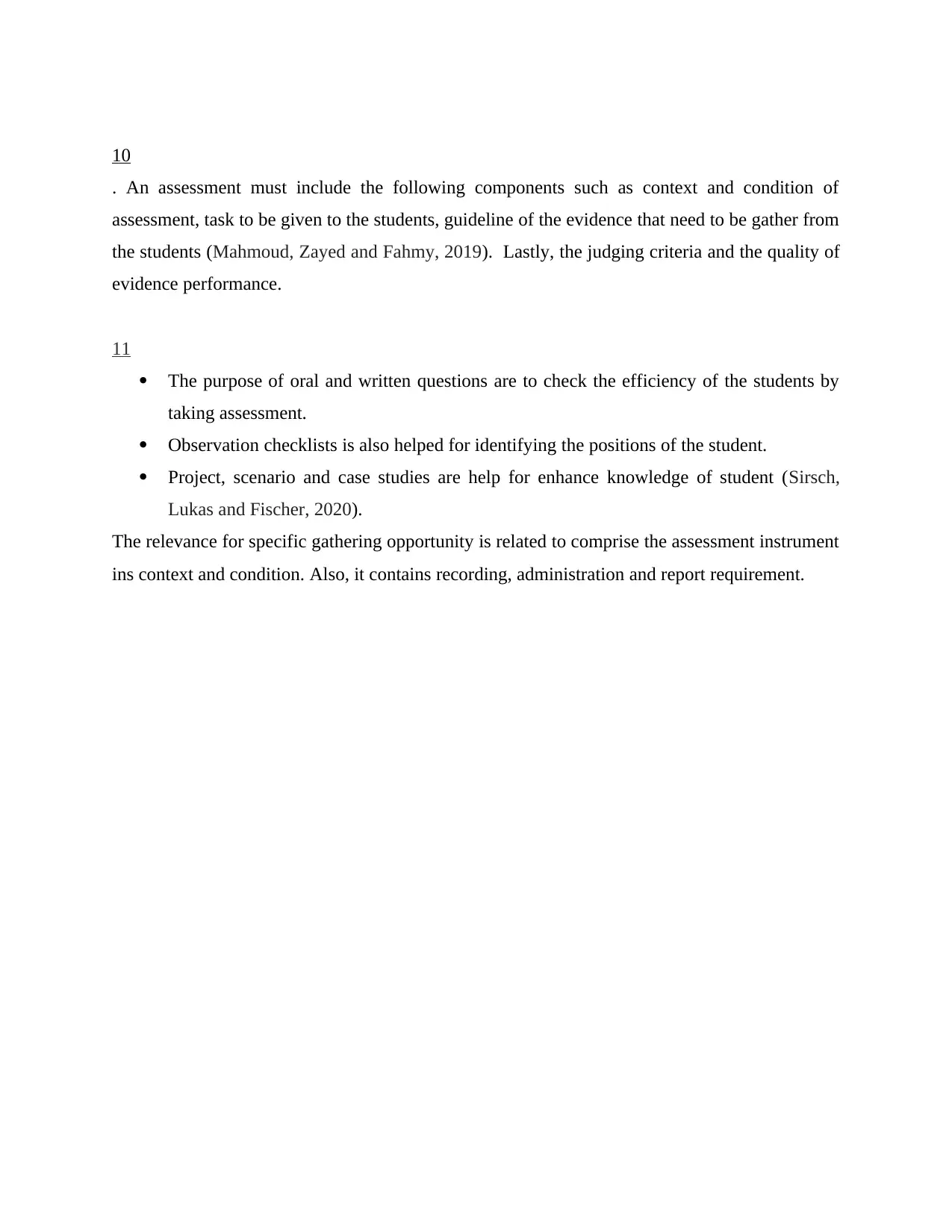
10
. An assessment must include the following components such as context and condition of
assessment, task to be given to the students, guideline of the evidence that need to be gather from
the students (Mahmoud, Zayed and Fahmy, 2019). Lastly, the judging criteria and the quality of
evidence performance.
11
The purpose of oral and written questions are to check the efficiency of the students by
taking assessment.
Observation checklists is also helped for identifying the positions of the student.
Project, scenario and case studies are help for enhance knowledge of student (Sirsch,
Lukas and Fischer, 2020).
The relevance for specific gathering opportunity is related to comprise the assessment instrument
ins context and condition. Also, it contains recording, administration and report requirement.
. An assessment must include the following components such as context and condition of
assessment, task to be given to the students, guideline of the evidence that need to be gather from
the students (Mahmoud, Zayed and Fahmy, 2019). Lastly, the judging criteria and the quality of
evidence performance.
11
The purpose of oral and written questions are to check the efficiency of the students by
taking assessment.
Observation checklists is also helped for identifying the positions of the student.
Project, scenario and case studies are help for enhance knowledge of student (Sirsch,
Lukas and Fischer, 2020).
The relevance for specific gathering opportunity is related to comprise the assessment instrument
ins context and condition. Also, it contains recording, administration and report requirement.
⊘ This is a preview!⊘
Do you want full access?
Subscribe today to unlock all pages.

Trusted by 1+ million students worldwide
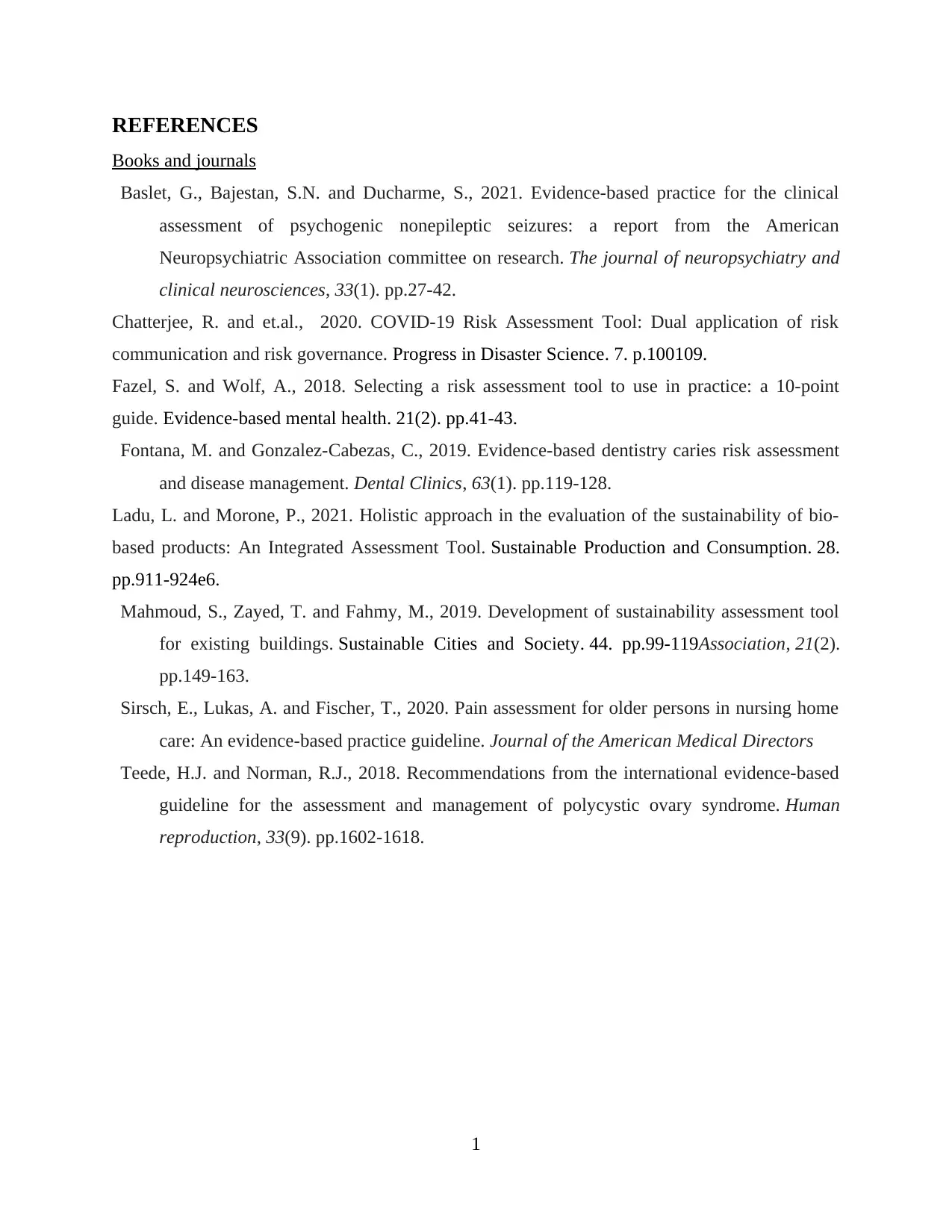
REFERENCES
Books and journals
Baslet, G., Bajestan, S.N. and Ducharme, S., 2021. Evidence-based practice for the clinical
assessment of psychogenic nonepileptic seizures: a report from the American
Neuropsychiatric Association committee on research. The journal of neuropsychiatry and
clinical neurosciences, 33(1). pp.27-42.
Chatterjee, R. and et.al., 2020. COVID-19 Risk Assessment Tool: Dual application of risk
communication and risk governance. Progress in Disaster Science. 7. p.100109.
Fazel, S. and Wolf, A., 2018. Selecting a risk assessment tool to use in practice: a 10-point
guide. Evidence-based mental health. 21(2). pp.41-43.
Fontana, M. and Gonzalez-Cabezas, C., 2019. Evidence-based dentistry caries risk assessment
and disease management. Dental Clinics, 63(1). pp.119-128.
Ladu, L. and Morone, P., 2021. Holistic approach in the evaluation of the sustainability of bio-
based products: An Integrated Assessment Tool. Sustainable Production and Consumption. 28.
pp.911-924e6.
Mahmoud, S., Zayed, T. and Fahmy, M., 2019. Development of sustainability assessment tool
for existing buildings. Sustainable Cities and Society. 44. pp.99-119Association, 21(2).
pp.149-163.
Sirsch, E., Lukas, A. and Fischer, T., 2020. Pain assessment for older persons in nursing home
care: An evidence-based practice guideline. Journal of the American Medical Directors
Teede, H.J. and Norman, R.J., 2018. Recommendations from the international evidence-based
guideline for the assessment and management of polycystic ovary syndrome. Human
reproduction, 33(9). pp.1602-1618.
1
Books and journals
Baslet, G., Bajestan, S.N. and Ducharme, S., 2021. Evidence-based practice for the clinical
assessment of psychogenic nonepileptic seizures: a report from the American
Neuropsychiatric Association committee on research. The journal of neuropsychiatry and
clinical neurosciences, 33(1). pp.27-42.
Chatterjee, R. and et.al., 2020. COVID-19 Risk Assessment Tool: Dual application of risk
communication and risk governance. Progress in Disaster Science. 7. p.100109.
Fazel, S. and Wolf, A., 2018. Selecting a risk assessment tool to use in practice: a 10-point
guide. Evidence-based mental health. 21(2). pp.41-43.
Fontana, M. and Gonzalez-Cabezas, C., 2019. Evidence-based dentistry caries risk assessment
and disease management. Dental Clinics, 63(1). pp.119-128.
Ladu, L. and Morone, P., 2021. Holistic approach in the evaluation of the sustainability of bio-
based products: An Integrated Assessment Tool. Sustainable Production and Consumption. 28.
pp.911-924e6.
Mahmoud, S., Zayed, T. and Fahmy, M., 2019. Development of sustainability assessment tool
for existing buildings. Sustainable Cities and Society. 44. pp.99-119Association, 21(2).
pp.149-163.
Sirsch, E., Lukas, A. and Fischer, T., 2020. Pain assessment for older persons in nursing home
care: An evidence-based practice guideline. Journal of the American Medical Directors
Teede, H.J. and Norman, R.J., 2018. Recommendations from the international evidence-based
guideline for the assessment and management of polycystic ovary syndrome. Human
reproduction, 33(9). pp.1602-1618.
1
1 out of 7
Related Documents
Your All-in-One AI-Powered Toolkit for Academic Success.
+13062052269
info@desklib.com
Available 24*7 on WhatsApp / Email
![[object Object]](/_next/static/media/star-bottom.7253800d.svg)
Unlock your academic potential
Copyright © 2020–2025 A2Z Services. All Rights Reserved. Developed and managed by ZUCOL.





